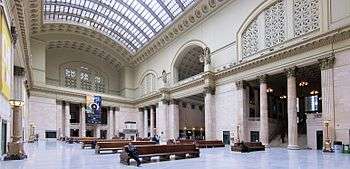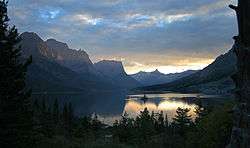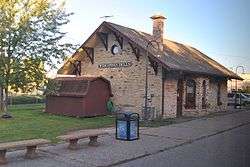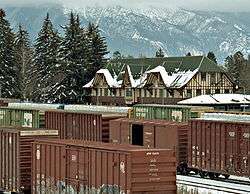Empire Builder
The Empire Builder is a daily long-distance Amtrak train connecting downtown Chicago to either Seattle or Portland, Oregon. The journey takes about 46 hours, longer if delays occur along the route. Passengers may be forced to take buses for part of the route if track work is being done. (Track work is not announced until the day of departure.) Equipment used is common to most Amtrak long-distance routes, with two-level Superliner passengers cars, sleeper cars, dining car, an observation/snack bar car, and possibly several baggage/expedited cargo cars.
- This article is an itinerary.
Route Overview
The Empire Builder begins its westbound journey at Chicago's Union Station. Passengers see the Chicago River and central Chicago as the train eases out of the station. The train heads north through the Chicago suburbs to Milwaukee before heading northwest through the pleasant countryside of central Wisconsin. Crossing the Mississippi River a couple of times, the train arrives at the St. Paul Union Depot around 10:30 PM.

As the passengers sleep, the train carries them across Minnesota, and well into North Dakota before sunrise. The route parallels US highway 2 much of this stretch. Sights include the high prairie, once-prosperous farming towns (now almost vanished). Wildlife, especially birds, deer and coyote are often seen.
Around noon, the Empire Builder crosses into Montana. As you enter Montana, at the left of the train, you can see the large flag and reconstructed fur trading post of the Fort Union National Monument. The train loosely follows the Missouri River (and the Lewis and Clark Trail) for about 130 miles between Williston ND and Wolf Point MT. This stretch passes through the Fort Peck Indian Reservation, one of several Indian reservations on the route.

The scenery remains rolling high plains for several more hours. In the late afternoon/early evening (depending on the season traveled in) the train arrives at Glacier National Park. In summer, the mountain vistas are beautiful—however, the light will fade quickly in winter, giving only a glimpse of the Rocky Mountains.
The train traverses the mountains through the second night, traveling down the Cascade Mountains and Skykomish River valley to the Puget Sound. After an hour or so following the waterfront, the Empire Builder arrives in Seattle (approx. 10:20 AM, typically).
Passengers bound for Portland, Oregon have their rail cars diverted at Spokane, WA in the middle of the second night. By the time it gets light in the morning you are well out of the mountains and are traveling down the north side of the Columbia River to Portland. This is actually one of the most scenic parts of the trip. You see log rafts, wind surfers, dams, sagebrush. The last part of the journey is through the spectacular Columbia River Gorge.
Empire Builder passengers traveling eastbound from Seattle/Portland see much more of the Glacier Park area and less of the plains. Thus, if you are only traveling in one direction, east-bound is preferable.
The total running length of this route is 2200 miles.
The American Industry Tour, an itinerary which features the industrialization of the United States, ending in mid-20th century Chicago, is a good prelude to the Empire Builder.
Stations
From east to west:
- 🌍 Chicago, Illinois
- 🌍 Glenview, Illinois
- 🌍 Milwaukee, Wisconsin
- 🌍 Columbus, Wisconsin
- 🌍 Portage, Wisconsin

- 🌍 Wisconsin Dells, Wisconsin
- 🌍 Tomah, Wisconsin
- 🌍 La Crosse, Wisconsin
- 🌍 Winona, Minnesota
- 🌍 Red Wing, Minnesota
- 🌍 Saint Paul, Minnesota — Thruway bus connection for Duluth
- 🌍 St. Cloud, Minnesota
- 🌍 Staples, Minnesota
- 🌍 Detroit Lakes, Minnesota
- 🌍 Fargo, North Dakota
- 🌍 Grand Forks, North Dakota
- 🌍 Devils Lake, North Dakota
- 🌍 Rugby, North Dakota
- 🌍 Minot, North Dakota
- 🌍 Stanley, North Dakota
- 🌍 Williston, North Dakota
- 🌍 Wolf Point, Montana
- 🌍 Glasgow, Montana
- 🌍 Malta, Montana
- 🌍 Havre, Montana
- 🌍 Shelby, Montana
- 🌍 Cut Bank, Montana
- 🌍 Browning, Montana - open from October to April
- 🌍 Glacier National Park (East Glacier), Montana
- 🌍 Essex, Montana - unstaffed
- 🌍 Glacier National Park (West Glacier), Montana

- 🌍 Whitefish, Montana
- 🌍 Libby, Montana
- 🌍 Sandpoint, Idaho - the only operating Amtrak station in Idaho
- 🌍 Spokane, Washington
Route to Portland
- 🌍 Pasco, Washington
- 🌍 Wishram, Washington - Wikipedia says "Although Wishram is one of the smallest communities served by Amtrak, it is an important gateway to the scenic recreational opportunities offered by the Columbia River."
- 🌍 Bingen–White Salmon, Washington
- 🌍 Vancouver, Washington - a connection can be made here to the Amtrak Cascades.
- 🌍 Portland, Oregon - a connection can be made here to the Amtrak Cascades.
Route to Seattle
_2005_05_23.jpg)
- 🌍 Ephrata, Washington
- 🌍 Wenatchee, Washington — Thruway bus connection for Omak
- 🌍 Leavenworth, Washington
- 🌍 Everett, Washington - a connection can be made here to the Amtrak Cascades.
- 🌍 Edmonds, Washington - a connection can be made here to the Amtrak Cascades.
- 🌍 Seattle, Washington - a connection can be made here to the Amtrak Cascades.